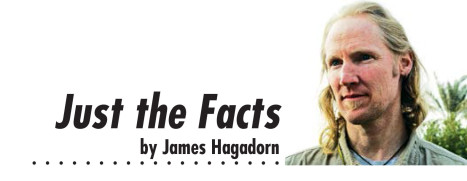 What’s the fastest-growing mountain in Colorado? It’s near DIA. And it’s not a volcano.
What’s the fastest-growing mountain in Colorado? It’s near DIA. And it’s not a volcano.
It’s a mountain of trash, dozed into a 250-foot-tall pyramid that towers above the nearest prairie dog. Mantled with frosting-like layers of dirt, this amazing pile of rubbish reminds me of Vegas’ Luxor hotel.
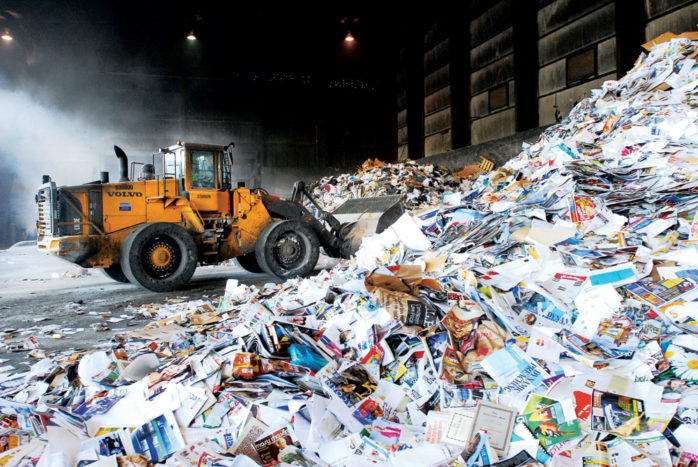
The post-consumer lifecycle of paper: Loading, separating, sorting, and baling paper for recycling.
Yet this landfill is only one of 60 such facilities around Colorado, all of which are aimed at taking care of our waste.
And boy do we generate some waste.
At home, each of us generates about two to four pounds per day. Depending on the mix of dense to fluffy stuff in our trash, our waste could be small enough to fit in a shoebox, or might be as big as a yoga ball.
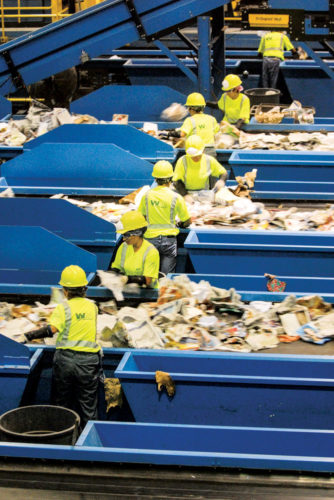
(Image courtesy of Waste Management)
Even more mind-blowing, though—we generate between two to four times this amount outside of our homes.
We produce some of it at our workplaces, schools and at restaurants. The rest of it is somewhat hidden because it’s generated from construction and maintenance of our “built environment” and products we consume. For example, construction and demolition materials like concrete, asphalt, drywall and roofing are major contributors to landfills. Our energy also generates a colossal amount of solid waste, whether it be the fly ash generated from coal-burning power plants, or waste lime from gas-fired power plants, or drilling muds and byproducts from production and refining of gasoline. Ditto for non-compostable agricultural waste, not to mention the sludge that comes from wastewater treatment facilities.
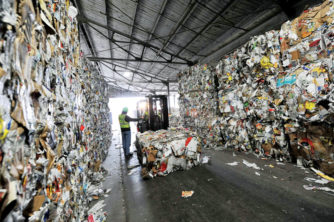
(Image courtesy of Waste Management)
Coloradans are “middle of the pack” waste generators, compared to the rest of the nation. After adding up all our direct and indirect waste, we generate about10–15 percent more waste on average per capita than people in other states.
Where does all this go? Most of it is deposited on the surface, often not too far from where we live. As our cities and towns spread, sometimes we’ve even grown right over our waste piles. Telltale signs let us know where this has happened. For example, few hikers passing by the white pipes sticking up from the ground in Red Rock Canyon Open Space know that the pipes vent decomposition gases from the former Gypsum Canyon Landfill. In Denver’s red-hot Belcaro neighborhood, visitors wonder why the asphalt roads have so many bumps and dips. Underneath lies a lurching landfill.
Every year, Coloradans get better at minimizing the impact of this waste, in part by recycling or repurposing some of it. New technology is helping too. Household waste, for example, is increasingly sorted both by people and by robots. Such as the plastic-zapping robotic blowguns that ricochet plastics from our recycling conveyor belts. Or the spider-like carton-grabber that pulls old juice and milk boxes out of the waste stream.
Some of our waste even helps fuel our infrastructure, like the tires burned to fuel formation of cement near Pueblo. Elsewhere, our old trash powers homes, like in Aurora where fermenting gases from buried trash are harnessed to generate electricity.
Solid waste management is big business here—as big as the marijuana industry. This billion-dollar enterprise employs thousands, and handles our most visible environmental footprint. Not to mention that its personnel are often the eyes and ears for our communities. Like the trash hauler who helped save a house in Aspen when he reported a gas smell in the driveway. The owners were gone and a falling icicle had severed the home’s gas line.
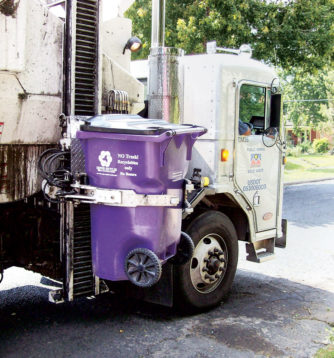
(Image Courtesy of Waste Management)
Despite all our progress, Coloradans have a long way to go to get up to national standards for recycling waste. For example, Americans living in cities recycle about 35 percent of their household waste, but with the exception of outliers like Fort Collins, in Colorado’s cities we only recycle upwards to 20 percent of our waste. In part, our recycling rates are low because we’ve never had a landfill crisis like some tightly packed coastal cities, and because waste management in Colorado is largely privatized, with recycling often only available as an optional service with an added fee. Also contributing to this perfect storm are Colorado’s extremely low landfill usage costs, mediocre commodity prices that make recycling less attractive, and extra shipping costs to export some of our recyclables to coastal distribution centers.
Solid waste’s costs and impacts aren’t always direct—most of them come from the infrastructure of our lives. Whether we recycle, compost, buy less, or just raise our awareness, each of us can help a little bit. Maybe it starts with a wink or a wave to our friendly trash truck driver. Whatever steps we take, collectively, let’s avoid making any more mountains out of molehills.
James Hagadorn, Ph.D., is a scientist at the Denver Museum of Nature & Science.
Suggestions and comments are welcome at jwhagadorn@dmns.org.


0 Comments